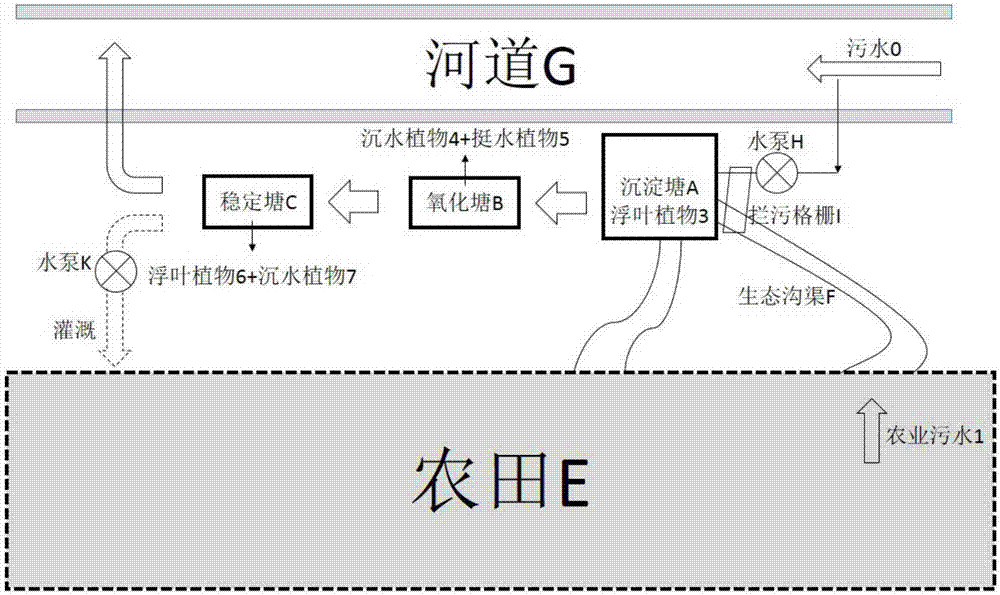Ditch-pond integrated system for controlling agricultural non-point source pollution and purifying river water and application method thereof
An integrated system and technology of ditches and ponds, applied in the field of water pollution control, can solve problems such as inability to efficiently purify polluted river water, and achieve the effect of ensuring ecological stability and high treatment efficiency
- Summary
- Abstract
- Description
- Claims
- Application Information
AI Technical Summary
Problems solved by technology
Method used
Image
Examples
Embodiment 1
[0042]When the farmland water flow is sufficient, the ditch pond system is operated in this way, and the steps are:
[0043] Agricultural sewage collection and treatment: Agricultural sewage 1 enters the sedimentation pond through the ecological ditch, and the trash grid in front of the sedimentation pond intercepts floating garbage and large particles of debris. 2 The lotus or planting density is 30 plants / m 2 Nymphaeum) retains suspended solids and sediment in sewage, and floating leaf plant 3 and floating leaf plant root microorganisms can absorb part of nutrients and remove part of N, P, COD Mn , ammonia nitrogen. The water from the sedimentation pond flows into the oxidation pond by itself, and a large number of submerged plants 4 are planted in the oxidation pond (the planting density is 12 plants / m 2 Hydrilla verticillium or planting density is 32 plants / m 2 bitter grass) and emergent plants 5 (planting density is 36 plants / m 2 The reed or planting density is 36 pla...
Embodiment 2
[0045] When the amount of water is insufficient, use this method to operate the ditch and pond system, and the steps are:
[0046] Agricultural sewage collection and treatment: Agricultural sewage 1 enters the sedimentation pond through the ecological ditch, and the trash grid in front of the sedimentation pond intercepts floating garbage and large particles of debris. In addition, river sewage is pumped into the sedimentation pond, and the trash grid in front of the sedimentation pond intercepts floating garbage and large particles of debris. The sedimentation pond consists of a large number of floating leaf plants 3 (the planting density is 2 plants / m 2 The lotus or planting density is 25 plants / m 2 Nymphaeum) retains suspended solids and sediment in sewage, and floating leaf plant 3 and floating leaf plant root microorganisms can absorb part of nutrients and remove part of N, P, COD Mn , ammonia nitrogen. The water from the sedimentation pond flows into the oxidation pon...
Embodiment 3
[0048] During the drought period, the steps to operate the ditch and pond system in this way are:
[0049] Agricultural sewage collection and treatment: river sewage is pumped into the sedimentation pond, and the trash grid in front of the sedimentation pond intercepts floating garbage and large particles of debris. The sedimentation pond consists of a large number of floating leaf plants 3 (the planting density is 1 plant / m 2 The lotus or planting density is 20 plants / m 2 Nymphaeum) retains suspended solids and sediment in sewage, and floating leaf plant 3 and floating leaf plant root microorganisms can absorb part of nutrients and remove part of N, P, COD Mn , ammonia nitrogen. The water from the sedimentation pond flows into the oxidation pond by itself, and a large number of submerged plants 4 are planted in the oxidation pond (the planting density is 15 plants / m 2 Hydrilla verticillium or the planting density is 30 plants / m 2 bitter grass) and 5 emergent plants (the p...
PUM
 Login to View More
Login to View More Abstract
Description
Claims
Application Information
 Login to View More
Login to View More - R&D
- Intellectual Property
- Life Sciences
- Materials
- Tech Scout
- Unparalleled Data Quality
- Higher Quality Content
- 60% Fewer Hallucinations
Browse by: Latest US Patents, China's latest patents, Technical Efficacy Thesaurus, Application Domain, Technology Topic, Popular Technical Reports.
© 2025 PatSnap. All rights reserved.Legal|Privacy policy|Modern Slavery Act Transparency Statement|Sitemap|About US| Contact US: help@patsnap.com

